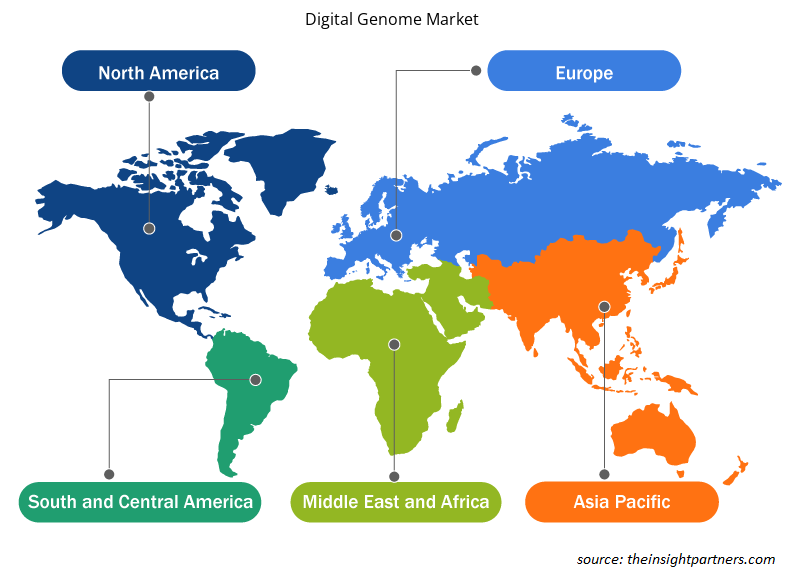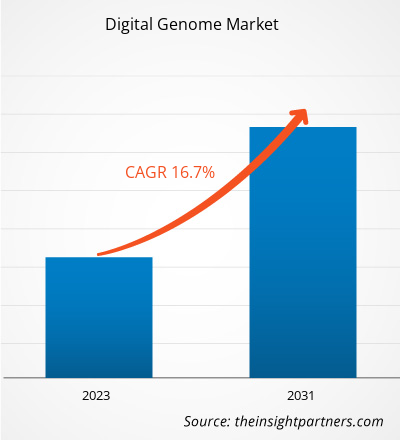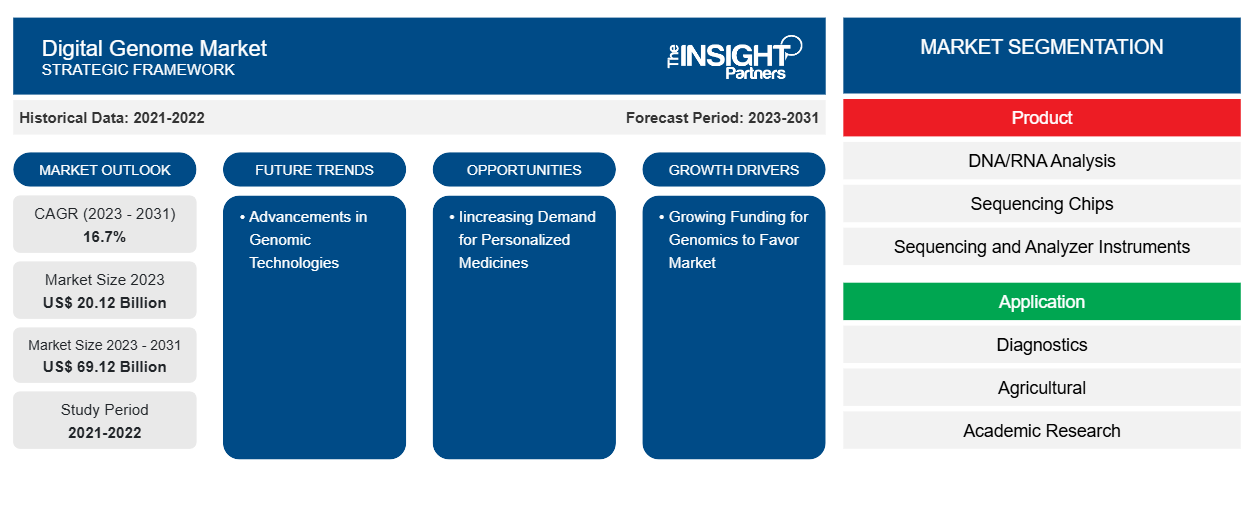Der Markt für digitale Genomforschung soll von 20,12 Milliarden US-Dollar im Jahr 2023 auf 69,12 Milliarden US-Dollar im Jahr 2031 anwachsen. Der Markt wird voraussichtlich zwischen 2023 und 2031 eine durchschnittliche jährliche Wachstumsrate (CAGR) von 16,7 % verzeichnen. Die steigende Nachfrage nach personalisierten Medikamenten dürfte ein wichtiger Trend auf dem Markt für digitale Genomforschung bleiben.
Digitale Genom-Marktanalyse
Chronische Krankheiten wie Diabetes, Herzkrankheiten , Schlaganfall, Krebs und Fettleibigkeit sind die häufigsten Todesursachen weltweit und verursachen den Großteil der nationalen Gesundheitskosten. Laut dem 2021 veröffentlichten Bericht des IDF Diabetes Atlas leben 537 Millionen Erwachsene mit Diabetes, und die Zahl soll bis 2030 auf 643 Millionen und bis 2045 auf 783 Millionen steigen. Darüber hinaus werden die wachsende geriatrische Bevölkerung und die damit verbundenen chronischen Krankheiten das Wachstum des Marktes für digitale Genome im Prognosezeitraum vorantreiben.
Marktübersicht zum digitalen Genom
Die Forschungsinstitute führen zahlreiche Projekte und Studien durch, um verschiedene Aspekte, Eigenschaften und Anwendbarkeit des digitalen Genoms in medizinischen Bereichen zu entdecken und zu untersuchen. Die Forschungsinstitute und akademischen Zentren gehen häufig Kooperationen mit privaten Unternehmen ein, um innovative Therapien zur Behandlung von Krankheiten zu entwickeln. Darüber hinaus wird erwartet, dass eine steigende Zahl von Investitionen im Rahmen von Forschungsprogrammen das Segmentwachstum vorantreiben wird. Vor kurzem vergab Illumina Zuschüsse und Sponsorings, um Forschung zu unterstützen, die sich mit der Mission befasst, die Macht des Genoms zu entfesseln und den Fortschritt der Genomik voranzutreiben . Die Vorteile und die Genauigkeit minimalinvasiver Operationen fördern das Wachstum des Marktes für digitale Genome.
Passen Sie diesen Bericht Ihren Anforderungen an
Sie erhalten kostenlos individuelle Anpassungen an jedem Bericht, einschließlich Teilen dieses Berichts oder einer Analyse auf Länderebene, eines Excel-Datenpakets sowie tolle Angebote und Rabatte für Start-ups und Universitäten.
-
Holen Sie sich die wichtigsten Markttrends aus diesem Bericht.Dieses KOSTENLOSE Beispiel umfasst eine Datenanalyse von Markttrends bis hin zu Schätzungen und Prognosen.
Treiber und Chancen auf dem Markt für digitales Genom
Wachsende Finanzierung für Genomik fördert Markt
Die Genomsequenzierung findet rasch Eingang in die klinische Praxis, und erhebliche staatliche Investitionen haben die Implementierung in Gesundheitssysteme unterstützt. So gab das vom Ministerium für Biotechnologie finanzierte und koordinierte Genome India Project im März 2024 bekannt, dass die Sequenzierung von 10.000 indischen Genomen abgeschlossen sei. Die vollständigen Genome, d. h. der DNA-Bauplan, aus dem der menschliche Körper besteht und der erhalten bleibt, wurden von 10.000 Individuen analysiert, um ein indisches „Referenz“-Menschengenom zu erstellen. Der Markt für digitale Genome wird im Prognosezeitraum voraussichtlich wachsen, da Hersteller und Regierung den Bereich der Genomik finanzieren.
Fortschritte in der Genomtechnologie – eine Chance auf dem Markt für digitale Genomforschung
Beispiellose Entwicklungen in der Genomforschung und -technologie haben das Potenzial für einen Wandel im Gesundheits- und Biowissenschaftssektor geschaffen. Die klinischen Anwendungen genomischer Technologien sind unendlich und bieten Möglichkeiten zur Verbesserung der Diagnose- und Behandlungsmöglichkeiten für chronische Krankheiten. Beispielsweise bieten sie ein enormes Potenzial für die Genentdeckung und Diagnose seltener monogener Erkrankungen. Genomische Technologien werden auch zur Diagnose von Menschen mit hochriskanten genetischen Fehlern eingesetzt, die zu seltenen Krankheiten führen. Darüber hinaus werden genomische Technologien zunehmend zur Analyse seltener und häufiger genetischer Faktoren eingesetzt. So erhielt Personal Genome Diagnostics im April 2020 die Zulassung der Food and Drug Administration (FDA) für den PGDx Elio Tissue Complete Test. Personal Genome Diagnostics (PGDx) beseitigt Hindernisse für präzise onkologische Tests, um zeitnahe, personalisierte Krebsbehandlungen für alle zu ermöglichen.
Segmentierungsanalyse des Marktberichts zum digitalen Genom
Wichtige Segmente, die zur Ableitung der Marktanalyse zum digitalen Genom beigetragen haben, sind Produkt, Anwendung und Endbenutzer.
- Basierend auf dem Produkt ist der Markt für digitale Genome in DNA-/RNA-Analyse, Sequenzierungschips, Sequenzierungs- und Analyseinstrumente, Instrumente zur Probenvorbereitung sowie Sequenzierungs- und Analysesoftware unterteilt. Das Segment Sequenzierungs- und Analyseinstrumente hatte im Jahr 2023 einen größeren Marktanteil.
- Basierend auf der Anwendung ist der Markt in Landwirtschaft, Diagnostik, akademische Forschung, personalisierte Medizin, Arzneimittelforschung und andere segmentiert. Das Diagnostiksegment hielt im Jahr 2023 einen größeren Marktanteil.
- In Bezug auf den Endverbraucher ist der Markt in akademische Forschungsinstitute, Diagnostik- und Forensiklabore, Krankenhäuser und andere unterteilt. Das Segment der Diagnostik- und Forensiklabore dominierte den Markt im Jahr 2023.
Marktanteilsanalyse für digitales Genom nach geografischer Lage
Der geografische Umfang des Berichts zum Markt für digitale Genomforschung ist hauptsächlich in fünf Regionen unterteilt: Nordamerika, Europa, Asien-Pazifik, Naher Osten und Afrika sowie Süd- und Mittelamerika. Der Markt für digitale Genomforschung in Nordamerika ist bedeutend. In Nordamerika wird das Wachstum des Marktes für digitale Genomforschung in erster Linie durch schnelle Screening-Technologien, eine zunehmende Präferenz für personalisierte Medizin, hohe F&E-Ausgaben für therapeutische Produkte und die Präsenz führender Marktteilnehmer in den USA vorangetrieben, die das Wachstum dieses Marktes in diesem Land beschleunigen werden. So kündigte beispielsweise das in den USA ansässige Unternehmen Nucleus Genomics im März 2024 die Einführung seines DNA-Analyseprodukts an, um allen die Vorteile der personalisierten Medizin zugänglich zu machen. Die oben genannten Faktoren werden sich voraussichtlich positiv auf das Wachstum des Marktes für digitale Genomforschung auswirken.
Regionale Einblicke in den Markt für digitale Genomik
Die regionalen Trends und Faktoren, die den Markt für digitale Genomforschung im Prognosezeitraum beeinflussen, wurden von den Analysten von Insight Partners ausführlich erläutert. In diesem Abschnitt werden auch die Marktsegmente und die Geografie des Marktes für digitale Genomforschung in Nordamerika, Europa, im asiatisch-pazifischen Raum, im Nahen Osten und Afrika sowie in Süd- und Mittelamerika erörtert.

- Erhalten Sie regionalspezifische Daten zum Markt für digitale Genomik
Umfang des Marktberichts zum digitalen Genom
| Berichtsattribut | Details |
|---|---|
| Marktgröße im Jahr 2023 | 20,12 Milliarden US-Dollar |
| Marktgröße bis 2031 | 69,12 Milliarden US-Dollar |
| Globale CAGR (2023 - 2031) | 16,7 % |
| Historische Daten | 2021-2022 |
| Prognosezeitraum | 2023–2031 |
| Abgedeckte Segmente |
Nach Produkt
|
| Abgedeckte Regionen und Länder |
Nordamerika
|
| Marktführer und wichtige Unternehmensprofile |
|
Dichte der Marktteilnehmer im Bereich Digitales Genom: Die Auswirkungen auf die Geschäftsdynamik verstehen
Der Markt für digitale Genomforschung wächst rasant, angetrieben durch die steigende Nachfrage der Endnutzer aufgrund von Faktoren wie sich entwickelnden Verbraucherpräferenzen, technologischen Fortschritten und einem größeren Bewusstsein für die Vorteile des Produkts. Mit der steigenden Nachfrage erweitern Unternehmen ihr Angebot, entwickeln Innovationen, um die Bedürfnisse der Verbraucher zu erfüllen, und nutzen neue Trends, was das Marktwachstum weiter ankurbelt.
Die Marktteilnehmerdichte bezieht sich auf die Verteilung der Firmen oder Unternehmen, die in einem bestimmten Markt oder einer bestimmten Branche tätig sind. Sie gibt an, wie viele Wettbewerber (Marktteilnehmer) in einem bestimmten Marktraum im Verhältnis zu seiner Größe oder seinem gesamten Marktwert präsent sind.
Die wichtigsten auf dem Markt für digitale Genomdaten tätigen Unternehmen sind:
- THERMO FISHER SCIENTIFIC INC.
- F.HOFFMANN-LA ROCHE LTD
- Illumina, Inc.
- QIAGEN
- GenomeMe Inc.
- NanoString Technologies, Inc.
Haftungsausschluss : Die oben aufgeführten Unternehmen sind nicht in einer bestimmten Reihenfolge aufgeführt.

- Überblick über die wichtigsten Akteure auf dem Markt für digitales Genom
Neuigkeiten und aktuelle Entwicklungen zum Markt für digitale Genome
Der Markt für digitale Genome wird durch die Erhebung qualitativer und quantitativer Daten nach Primär- und Sekundärforschung bewertet, die wichtige Unternehmenspublikationen, Verbandsdaten und Datenbanken umfasst. Im Folgenden finden Sie eine Liste der Entwicklungen auf dem Markt für Innovationen, Geschäftserweiterungen und Strategien:
- Im Januar 2023 brachte QIAGEN Digital Insights (QDI) die QIAGEN CLC Genomics Workbench Premium auf den Markt, die den Datenanalyse-Engpass der Sequenzierung der nächsten Generation (NGS) beseitigt, indem sie die Sequenzierung des gesamten Genoms (WGS), Sequenzierungsdaten großer Panels und die Sequenzierung des gesamten Exoms (WES) analysiert und interpretiert. (Quelle: QIAGEN, Pressemitteilung)
- Im August 2022 starteten das Mount Sinai Health System und die Icahn School of Medicine gemeinsam mit dem Regeneron Genetics Center (RGC) ein neues Forschungsprojekt zur Sequenzierung des menschlichen Genoms namens Mount Sinai Million Health Discoveries Program. Ziel ist es, Forschern einzigartige Datensätze zur Verfügung zu stellen, die ihnen helfen, das wahre Potenzial genetisch basierte, präzise medizinische Ansätze zur Steuerung der täglichen Patientenversorgung einzuschätzen. (Quelle: Mount Sinai Health System, Newsletter)
Abdeckung und Ergebnisse des Marktberichts zum digitalen Genom
Der Bericht „Digital Genome Market Size and Forecast (2021–2031)“ bietet eine detaillierte Analyse des Marktes, die die folgenden Bereiche abdeckt:
- Größe und Prognose des digitalen Genommarktes auf globaler, regionaler und Länderebene für alle wichtigen Marktsegmente, die im Rahmen des Berichts abgedeckt sind
- Marktdynamik wie Treiber, Beschränkungen und wichtige Chancen
- Markttrends zum digitalen Genom
- Detaillierte PEST- und SWOT-Analyse
- Marktanalyse für digitale Genome mit wichtigen Markttrends, globalen und regionalen Rahmenbedingungen, wichtigen Akteuren, Vorschriften und aktuellen Marktentwicklungen
- Branchenumfeld und Wettbewerbsanalyse für das digitale Genom, einschließlich Marktkonzentration, Heatmap-Analyse, prominenten Akteuren und aktuellen Entwicklungen
- Detaillierte Firmenprofile
- Historische Analyse (2 Jahre), Basisjahr, Prognose (7 Jahre) mit CAGR
- PEST- und SWOT-Analyse
- Marktgröße Wert/Volumen – Global, Regional, Land
- Branchen- und Wettbewerbslandschaft
- Excel-Datensatz
Aktuelle Berichte
Verwandte Berichte
Erfahrungsberichte
Grund zum Kauf
- Fundierte Entscheidungsfindung
- Marktdynamik verstehen
- Wettbewerbsanalyse
- Kundeneinblicke
- Marktprognosen
- Risikominimierung
- Strategische Planung
- Investitionsbegründung
- Identifizierung neuer Märkte
- Verbesserung von Marketingstrategien
- Steigerung der Betriebseffizienz
- Anpassung an regulatorische Trends























 Kostenlose Probe anfordern für - Markt für digitales Genom
Kostenlose Probe anfordern für - Markt für digitales Genom